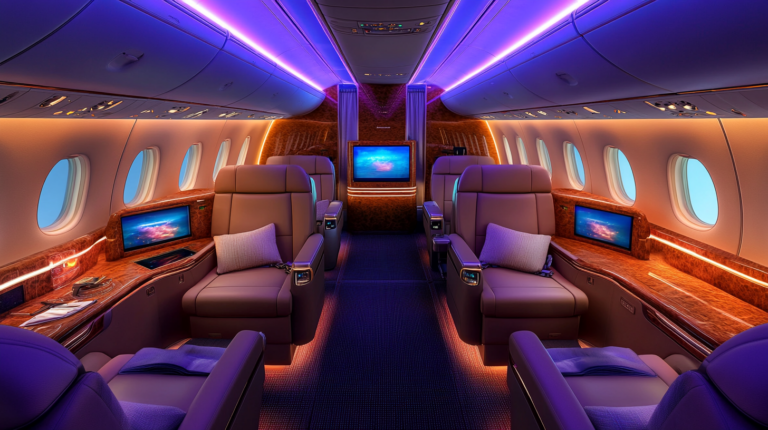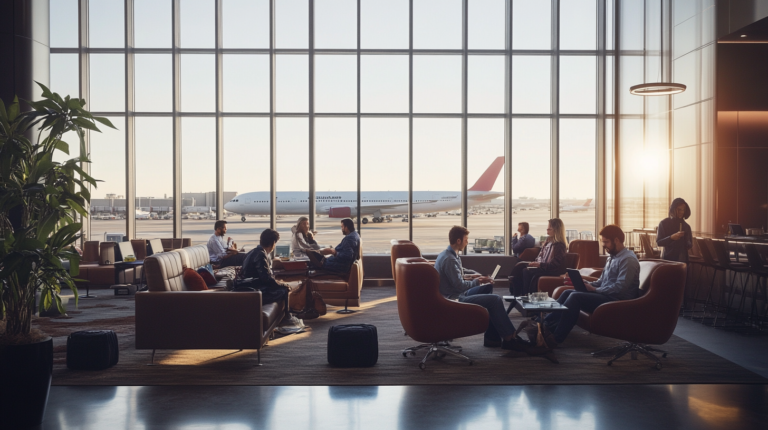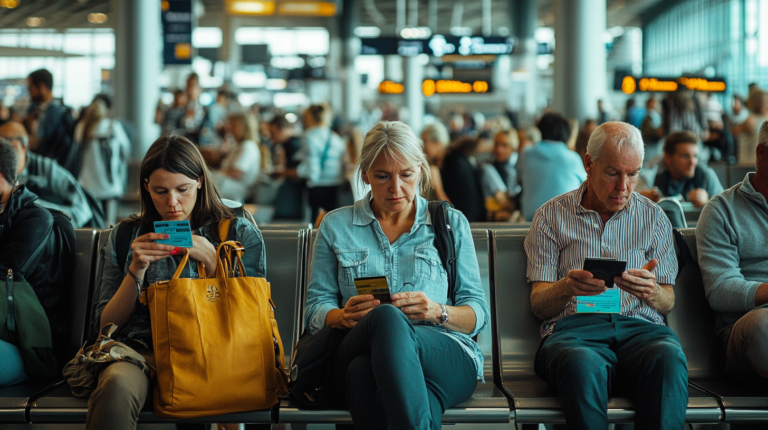Gate Lice: Navigating Airport Crowds and Improving Your Boarding Experience
The term “gate lice” has become an increasingly familiar, albeit unflattering, part of the modern air travel lexicon. Coined by frequent flyers and airline crews alike, it refers to passengers who cluster anxiously around the boarding gate long before their boarding group is called. This behavior often leads to unnecessary congestion, confusion, and mounting frustration among fellow travelers and airline staff.
Despite being a longstanding issue in airports worldwide, the phenomenon of “gate lice” has recently surged back into the spotlight due to evolving travel dynamics and emerging challenges in the post-pandemic era. With heightened anxiety in the post-COVID-19 travel landscape and increasing competition for the coveted overhead bin space—exacerbated by rising baggage fees—the “gate lice” phenomenon appears to be on the rise.
Airlines are now seeking innovative solutions to address this persistent challenge, aiming to enhance the boarding experience for all passengers while maintaining operational efficiency. This comprehensive article delves into the underlying reasons behind the “gate lice” behavior, its far-reaching impact on air travel, and how airlines like American Airlines are pioneering responses to manage and mitigate this issue. Additionally, we explore strategies that passengers can adopt to contribute to a smoother boarding process.
The Rise of “Gate Lice” in Post-Pandemic Travel
The COVID-19 pandemic has irrevocably changed the dynamics of air travel, introducing new layers of complexity and concern for passengers worldwide. Health and safety have become paramount, and with constantly evolving travel restrictions and safety protocols, passengers are experiencing heightened levels of stress and uncertainty. These factors have amplified passenger anxiety, contributing to the resurgence and intensification of “gate lice” behavior.
Many travelers are eager to secure their spot on the plane as early as possible, driven not only by fears of limited overhead bin space but also by a desire to control their immediate environment and minimize close contact with others. This eagerness often manifests in crowding around boarding areas well before the boarding process officially begins. Passenger Anxiety and Air Travel Post-COVID-19
Industry experts have noted that the surge in carry-on luggage, a direct consequence of airlines implementing and increasing checked baggage fees, has significantly exacerbated the “gate lice” issue. Passengers, aiming to avoid additional fees and ensure their personal belongings are safely stored, prefer to carry their luggage onto the plane. The worry of not finding adequate overhead bin space prompts many to queue up at the gate well before boarding begins. This behavior not only creates unnecessary congestion but also disrupts the boarding process efficiency, leading to potential delays and a less pleasant experience for everyone involved. Airline Baggage Policies and Passenger Behavior
The pandemic has also heightened awareness and sensitivity regarding personal space and health safety protocols. Ironically, the tendency of passengers to crowd the boarding gate conflicts with the desire to maintain social distancing. This paradox makes the crowding at gates even more problematic, particularly for passengers who are elderly, have mobility issues, or require special assistance. These individuals often find it challenging to navigate through the densely packed groups of passengers eager to board. Such situations highlight the pressing need for more orderly and well-managed boarding procedures that can accommodate the needs of all passengers while adhering to health and safety guidelines. Social Distancing Challenges in Airport Environments
This anxiety-driven behavior reflects broader concerns prevalent in contemporary air travel. The fear of lost or mishandled luggage has become more pronounced, prompting travelers to keep essential items within reach at all times. Additionally, uncertainties related to flight changes or cancellations have heightened the desire for passengers to be among the first to board, ensuring they can secure their carry-on luggage and settle in without complications. The culmination of these factors has led to a notable increase in “gate lice” incidents at airports around the globe, signaling a need for both airlines and passengers to reevaluate boarding habits and processes. Fear of Lost Luggage in Air Travel
Airlines Respond: American Airlines’ Innovative Approach
Recognizing the negative impact of “gate lice” on both the passenger experience and operational efficiency, airlines are proactively exploring and implementing new strategies to mitigate the issue. American Airlines, in particular, has taken significant steps by testing innovative technological solutions designed to manage and reduce gate crowding more effectively. By leveraging technology, they aim to streamline the boarding process, uphold boarding priorities, and enhance overall passenger satisfaction. American Airlines’ Technological Solutions for Boarding
In select airports, including Albuquerque, Tucson, and Ronald Reagan Washington National Airport, American Airlines has piloted a new boarding system that incorporates advanced technology to enforce boarding order compliance. The system features an automated alert mechanism that audibly notifies gate agents when a passenger attempts to board before their assigned group is called. Specifically, when a boarding pass is scanned, the system cross-references the passenger’s boarding group with the current group being boarded. If a mismatch is detected, an audible beep sounds, and a clear message is displayed on the gate agent’s screen, indicating that the passenger should wait for their appropriate boarding group. This not only assists gate agents in managing the boarding process more efficiently but also serves as a subtle deterrent to passengers contemplating jumping the line, promoting fairness and orderliness in boarding. American Airlines’ Boarding Alert System
Initial feedback from these pilot tests has been encouraging. Passengers and staff have reported a noticeably more orderly boarding experience, characterized by reduced crowding and less confusion at the gates. The technological approach not only reinforces the integrity of the boarding process but also alleviates the pressure on gate agents, who previously had to manually enforce boarding group compliance. By proactively addressing both the symptoms and root causes of “gate lice” behavior, American Airlines aims to enhance operational efficiency and significantly improve overall customer satisfaction. The successful implementation of such systems could set a new standard for boarding procedures industry-wide. Benefits of Automated Boarding Systems
Comparative Strategies: How Other Airlines Are Addressing the Issue
While American Airlines pioneers with technological innovation, other airlines are also actively seeking solutions to the “gate lice” issue, employing a variety of strategies tailored to their operational models. United Airlines, for instance, has extended its boarding enforcement policy to over 100 airports across its network. United’s approach involves a system where boarding pass scanners are configured to trigger a loud audible alert when a passenger attempts to board out of turn. This immediate feedback prompts gate agents and passengers alike to correct the boarding sequence, ensuring that priority boarding privileges are respected and that the boarding process remains orderly. By implementing such measures, United Airlines aims to enhance the boarding experience and reduce instances of gate crowding. United Airlines’ Boarding Enforcement Policies
Conversely, airlines such as Delta Air Lines and Southwest Airlines have not yet integrated these technological solutions into their boarding processes. These carriers continue to rely on traditional methods, placing emphasis on clear communication, signage, and the proactive involvement of gate agents to enforce boarding group order. While these methods can be effective, they often depend heavily on individual agent diligence and passenger compliance, which can vary widely. This variability in enforcement and boarding procedure consistency can lead to different experiences for passengers, sometimes causing confusion or perceived unfairness. The reliance on human enforcement alone highlights the potential benefits that technological aids could bring in standardizing and improving the boarding experience. Traditional Boarding Procedures and Their Effectiveness
In addition to technological and policy-based approaches, some airlines and airports are experimenting with innovative boarding processes designed to mitigate crowding and streamline passenger flow. For example, some airlines are revisiting their boarding group strategies, experimenting with back-to-front boarding, window-middle-aisle sequences, or even randomized boarding groups to reduce congestion in the jet bridge and cabin aisles. Others are investing in passenger education, utilizing pre-boarding announcements, visual aids, and staff guidance to encourage passengers to remain seated until their group is called. These varied strategies reflect the airlines’ efforts to balance operational efficiency with customer service, addressing the “gate lice” problem from multiple angles. Alternative Boarding Methods in the Airline Industry
Ultimately, these varied strategies underscore the ongoing effort within the airline industry to balance operational efficiency, cost considerations, and customer service excellence. By addressing the root causes of the “gate lice” phenomenon—such as baggage policies that incentivize carry-on luggage and boarding procedures that may inadvertently encourage early queuing—airlines are striving to create a smoother, more pleasant experience for all passengers. Through a combination of technological innovation, policy adjustments, and enhanced communication, the industry aims to make the boarding process more efficient and less stressful, benefiting both travelers and airline staff alike. Improving Customer Experience in Air Travel
The Impact on Passengers and Airline Staff
The prevalence of “gate lice” behavior exerts tangible and multifaceted effects on both passengers and airline staff. For travelers, the crowding and congestion at the boarding gate can significantly increase stress levels and contribute to a less pleasant travel experience. Passengers who require special assistance—including the elderly, individuals with disabilities, and families traveling with young children—often find it particularly challenging to navigate through the densely packed groups. This can lead to delays in their boarding, increased anxiety, and a sense of frustration. Moreover, priority passengers who have paid for or earned early boarding privileges may feel their experience is diminished when they have to contend with unmanaged crowding at the gate. Challenges Faced by Special Needs Passengers During Boarding
Flight attendants and gate agents bear the brunt of managing the repercussions of “gate lice” behavior. The added challenge of controlling large groups of passengers who are eager to board before their assigned groups intensifies the strain on gate agents, whose responsibilities already include coordinating boarding procedures, assisting passengers with queries, and ensuring compliance with airline policies. This strain can potentially impact overall operational efficiency, leading to boarding delays and negatively affecting on-time departures. The increased pressure also contributes to staff fatigue and can detract from the quality of customer service provided. Impact of Passenger Behavior on Airline Staff
Furthermore, the boarding process often sets the tone for the entire flight experience. A chaotic and stressful start can adversely affect passenger mood, leading to increased dissatisfaction and potentially influencing perceptions of the airline’s overall service quality. First impressions are crucial, and airlines are keenly aware that the boarding experience is a significant touchpoint in the customer’s journey. In an industry where customer loyalty and positive word-of-mouth are invaluable, ensuring a smooth and pleasant boarding process is essential for maintaining a competitive edge. Importance of Boarding Experience in Customer Satisfaction
By proactively addressing “gate lice” behavior, airlines stand to gain on multiple fronts. Operational efficiency can be significantly improved through reduced boarding times and minimized delays, directly impacting airline schedules and bottom lines. For passengers, a smoother boarding process enhances the overall travel experience, reducing stress and increasing satisfaction with the airline. For airline staff, particularly gate agents and flight attendants, managing an orderly boarding process can alleviate job stress and allow them to focus on providing excellent customer service. The combined effect of these improvements can lead to stronger customer loyalty, positive brand perception, and a more profitable operation for the airline. Benefits of Efficient Boarding for Airlines and Passengers
Strategies for Passengers: How to Avoid Being “Gate Lice”
Passengers play a crucial role in alleviating the “gate lice” issue. By understanding boarding procedures and exercising patience, travelers can contribute to a smoother boarding experience for everyone. Here are some strategies to consider:
Stay Informed: Make it a habit to monitor boarding times and group numbers displayed prominently on airport departure screens, gate signs, or through airline mobile applications. Ensuring you are up-to-date with any changes or announcements helps prevent unnecessary waiting at the gate. By knowing exactly when your group is scheduled to board, you can remain seated or enjoy airport amenities until it’s time to proceed, thereby reducing crowding and making the experience more pleasant for everyone. Using Airline Apps to Stay Updated on Boarding Information
Respect Boarding Zones: Airlines typically have designated seating areas near the gate for passengers to wait comfortably until their boarding group is called. By remaining in these areas or in nearby lounges, you reduce congestion directly at the gate. This practice shows consideration for priority passengers, such as those needing extra assistance or those who have paid for early boarding privileges, allowing them to board smoothly without obstruction. Patience and adherence to boarding zones contribute significantly to an orderly and efficient boarding process. Understanding Airline Boarding Zones and Priority Policies
Consider Baggage Options: If securing overhead bin space is a primary concern, there are several strategies you can employ to alleviate this issue. Consider checking your bags, especially if the airline offers complimentary checked baggage allowances or if the convenience outweighs the cost. Alternatively, investigate whether your airline’s branded credit card or frequent flyer program offers early boarding perks, which can guarantee earlier access to overhead bins. Packing lighter or using under-seat personal items can also reduce reliance on overhead bin space, easing the pressure to board early. Maximizing Carry-On Space and Baggage Strategies
Practice Patience and Courtesy: Recognize that the boarding process is carefully structured to ensure efficiency and fairness. Exercising patience by waiting for your boarding group not only diminishes personal stress but also fosters a more courteous and calm environment. Being considerate of fellow passengers and airline staff contributes to a positive atmosphere and can ultimately lead to a more enjoyable travel experience for everyone involved. Small acts of courtesy, like allowing others to pass or offering assistance, can make a significant difference in reducing collective stress and improving overall satisfaction. Benefits of Patience and Courtesy in Air Travel
Plan Ahead: Arrive at the gate with enough time to relax and prepare for boarding. Rushing can lead to unnecessary stress and the temptation to crowd the gate area. By managing your time wisely, you can avoid anxiety and contribute to a more orderly boarding process. Effective Time Management for Stress-Free Travel
Listen to Announcements: Pay attention to gate announcements and instructions from airline staff. They often provide important information about boarding procedures, gate changes, or flight updates that can affect your travel. Staying informed helps you adjust accordingly without adding to gate congestion. Importance of Following Gate Announcements
Conclusion: Towards a Better Boarding Experience
The “gate lice” phenomenon underscores the intricate complexities of modern air travel, where passenger behaviors, airline policies, safety considerations, and logistical challenges intertwine. It reflects the underlying anxieties that many travelers experience, often exacerbated by external factors such as health concerns, heightened security measures, and evolving airline fee structures. As airlines like American Airlines take proactive steps by implementing innovative solutions to address gate crowding, there is optimism for a future where the boarding process is more streamlined, efficient, and enjoyable for all parties involved. Future of Boarding Procedures in Aviation
By gaining a deeper understanding of the reasons behind “gate lice” behavior—such as the desire for control, anxiety over luggage space, and general stress associated with air travel—passengers can become more mindful of their actions and their impact on others. Cooperation with boarding procedures and adherence to airline guidelines empowers passengers to actively contribute to a more pleasant and efficient travel experience. Simultaneously, airlines continue to refine their approaches, leveraging technology, policy adjustments, and customer feedback to balance operational efficiency with high levels of customer satisfaction. This collaborative effort between passengers and airlines is key to transforming the boarding process for the better. Passenger-Airline Collaboration for Improved Travel
In conclusion, effectively addressing the “gate lice” issue necessitates a concerted and collaborative effort among all stakeholders in the air travel experience. Airlines, by adopting innovative technologies and refining policies, play a crucial role in shaping the boarding environment. Passengers, by exercising patience, staying informed, and adhering to boarding protocols, contribute significantly to the efficacy of these measures. Together, these efforts pave the way towards a future where boarding is not a source of stress or frustration but rather an efficient, organized, and even pleasant part of the travel journey. Such advancements not only enhance individual experiences but also elevate the overall standard of air travel globally. Collaborative Solutions in Air Travel Industry
For more insights into maximizing your travel experience, expert advice, and the latest industry updates, visit us at milesBUZZ. We aim to keep you informed and ready for your next adventure!












